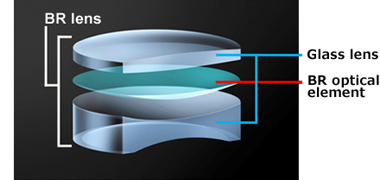News Release
Canon develops new camera-lens optical element that enables exceptionally high levels of chromatic aberration correction
TOKYO, August 27, 2015—Canon Inc. today announced that it has developed a new Blue Spectrum Refractive (BR) optical element for use in camera lenses that corrects for chromatic aberrations at an exceptionally high level to make possible superior imaging performance.

Composite lens employing the BR optical element

Cross section of the BR lens and the raw material used to make the BR optical element (organic optical material)
The new Canon-developed BR optical element offers characteristics that significantly refract blue light, which lies within the short-wavelength range, to achieve impressive levels of chromatic aberration correction for outstanding imaging performance. The BR optical element, sandwiched between two glass lens elements to create a BR lens, will make its debut in the new EF35mm f/1.4L II USM wide-angle fixed-focal-length lens, which is scheduled to go on sale in October 2015.
Natural light, or white light, comprises a spectrum of wavelengths, or colors, each of which realizes a unique refractive index when passing through a lens. As all colors do not converge on the same point, this disparity causes chromatic aberrations, or color fringing, to occur in an image.
Canon develops optical elements by reviewing organic optical materials, beginning with the design of molecular structures, with the aim of achieving optimal chromatic aberration correction that suppresses color fringing. With the successful development of the BR optical element, which offers unique light-dispersion characteristics that significantly refract blue light—a wavelength that, until now, had proven particularly difficult to converge to a specific focal point—Canon is able to develop lenses that make possible outstanding imaging performance by correcting for chromatic aberrations at an exceptionally high level.
